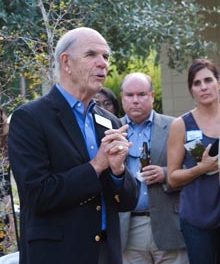 Another beautiful spring day engulfed us a few weeks ago. Us, as in a small group that facetiously calls itself “the captains of industry” and enjoys going to lunch to better reflect on whatever concerns of the day capture our attention. As usual, we had a terrific time sorting the extraordinary from the routine as we dug into salads and gumbo.
Another beautiful spring day engulfed us a few weeks ago. Us, as in a small group that facetiously calls itself “the captains of industry” and enjoys going to lunch to better reflect on whatever concerns of the day capture our attention. As usual, we had a terrific time sorting the extraordinary from the routine as we dug into salads and gumbo.
Later that day, it occurred to me that sometimes it doesn’t take much to get one excited about headline grabbing events. And that can be a good thing, one that dovetails with the notion that the ability to be surprised if not stunned is probably healthy. Certainly one doesn’t want to become inoculated against the value of being routed outside one’s comfort zone. This in turn got me thinking about all the times lately when I have been flabbergasted or, at a minimum, taken aback. Collectively, these times must at least signify that I was paying attention. Or am now. Here are just a few of those experiences.
1. A question about a favorite musician got me looking at a Rolling Stone magazine list, compiled by “experts,” of the 100 all-time top rock guitarists. While this list covers many terrific performers, it includes only two women (Joni Mitchell at #75 and Bonnie Raitt at 89, and do either of them really play rock and roll?). How can that be? Maybe the judges did not include enough men (unless you think 5% was enough). Or maybe musically gifted women usually have enough sense to want to make their mark in a venue less associated with crazy hours and risky behavior– like drugs and lack of sleep, perhaps. Throw in some sex role stereotypes and there you have it. But still, 2 women out of 100? There must have been a higher percentage of women than that among early American railroad engineers, sword swallowers, bounty hunters or barrel makers.
2. For anyone who was ever enchanted by this 1939 movie classic, Aljean Harmetz’s “The Making of The Wizard of Oz” (1977, Bantam Doubleday Dell) is simply riveting. Going far behind the cameras into the nearly entombed details of the process used by MGM to deliver a five star blockbuster, Harmetz fondly takes the movie and studio apart like an excited child dismantling a Christmas watch. Who knew there were 500 carpenters at MGM in 1938, not to mention 15 plumbers, 24 men in the blacksmith’s shop and 12 in the foundry? (Ah, they used 124 midgets, now that you ask, and the rest room arrangements– which included MGM employees who spent their entire day assisting in this process– approximated a circus production line.)
And how could it be that Ray Bolger, Jack Haley and Bert Lahr playing the Scarecrow, Tin Woodsman and Cowardly Lion “were not allowed to eat in the commissary”? Apparently, “they tried it once, dressed in bathrobes, their legs bare, their faces covered with rubber and fur and aluminum paste. They were told they looked disgusting.” An accommodation was made such that if they would eat in their dressing rooms, the studio would pay for their lunch (such a deal!). Certainly no one wanted to eat on the set, as the hot lighting used to compensate for slow color film meant that temperatures soared well over 100 degrees. Employees regularly fainted and had to be carried off for medical care.
Well, apart from the creativity, it’s all about making money, right? Surely “The Wizard of Oz” made a fortune… or did it? According to Ms. Harmetz’s research, the film cost about $2.75M to make (peanuts in today’s terms though a very hefty sum during the Depression) but it did not go into the black until some 20 years after its release.
3. Across the Atlantic not long after Oz (summer and fall 1940), Britain fought the German air force all but alone, enduring week after pounding week of devastating airstrikes from the Luftwaffe during the Battle of Britain. Under the fierce leadership of Winston Churchill at 10 Downing street and Sir Hugh (“Stuffy”) Dowding at the Royal Air Force, young RAF pilots flew their single engine Spitfires and Hurricanes against Germany’s powerful Luftwaffe with sharply decreasing training and often no prior experience firing their eight 7.7 mm Browning machine guns, not to mention engaging experienced enemy pilots at over 300 mph. These were frequently 19-21 or so year olds, desperate to protect their homeland, who knew their odds of coming back alive were often doubtful… but up they streaked into history armed with a belly full of coffee and an angel for a wingman.
4. The ingenuity and heroics displayed day after day by U.S. sailors, soldiers, marines and airmen during WWII knew no appreciable limits. In
“The War Below” (2013, Simon & Schuster), Charleston native James Scott brilliantly chronicles the gut wrenching patrols of three of the top performing submarines that the U.S. Navy threw at the Japanese in the Pacific during WWII.
Mr. Scott’s recounting of Pharmacist’s Mate 1st Class Thomas Moore (age 22) performing an emergency appendectomy on Petty Officer 3rd Class George Platter (age 18) while Silversides skipper Creed Burlingame held the boat at a depth of 100 feet to minimize turbulence is simply beyond the pale. Enlisting the help of several crew members, Moore performed this surgery using only a rudimentary surgical kit and barely sufficient anesthesia– which wore off during the operation. Just as the reader manages to catch his breath at the successful conclusion of this terrifying procedure, Silversides was subject to a massive depth charge attack that was forceful enough to throw Platter out of his bunk.
5. I noted here in “Magic Patches” that it’s often easy to re-establish relationships at a class reunion. Just last month, Mark Roth, a good friend from college, wrote to let me know he’d soon be vacationing in Charleston with his family. We hadn’t seen each other in 40 years and thought it would be great to try to get together. After trading e-mails to pin down a time and place, I headed off to see him.
We had such a marvelous time I am still pretty near speechless. We had the best time on earth, anchored in that eerie yet reassuring sense (cue the “Twilight Zone” music) of the time lapse having been more like 40 days than 40 years. What a treat to have the wherewithal to get caught up a bit and be able to share a wonderful carriage tour downtown, poolside dinner, and boatloads worth of laughs and delightful conversation. The entire experience was simply priceless. How can that be, we wondered. All those years spent hundreds of miles apart and yet we found ourselves right there in the moment as if nothing had ever intervened. Connected in the marsh.
All the way home I kept asking myself, “How can that be?” The next thing you know scientists will be talking about cancer cures as if they are right around the corner. Oh wait a minute, they are right around the corner. Maybe we’d better all get fitted out for flight suits. And expect the rides of a lifetime.







